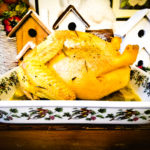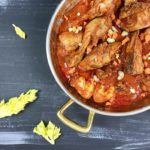BEANS “ALL’UCCELLETTO” WITH SAUSAGE

In the trattorie of Florence I have heard shelled beans cooked in this way called “fagiouli all’uccelletto”.
(Pellegrino Artusi, Science in the Kitchen and the Art of Eating Well)
This recipe is a typical Florentine way to eat their beloved cannellini beans which have replaced meat for centuries. The name originates from the way small game birds were cooked in Tuscany, seasoned with a generous amount of sage.
The bean’s abundance in vegetable proteins and fibre has nourished Mediterranean populations for centuries. In these times of abundance, they are still quite appreciated.
Beans are an excellent side dish, but you can add sausages to the basic recipe and create an excellent traditional Tuscan main course.
There are many versions of this recipe, some include onion and seasoning. The recipe reported by our Romagna gentleman consists of sage and tomato, I personally love adding garlic.
The first recipe we find in the original cookbook of Italian cuisine is the one which considers beans as a side dish, excellent for accompanying stewed meats. In it, the beans are browned in a substantial amount of oil and sage, and later enriched with tomato sauce. I prefer to use a milder temperature and less oil.
Prep Time: 5 minutes | Cooking Time: 35 minutes | Total Time: 40 minutes | Yield: Makes 4 servings.
Ingredients
- 500 g beans, already cooked in water with a poached garlic clove, a sprig of rosemary and 3 sage leaves. Reserve the cooking liquid.
- 4 sausages
- 2 garlic cloves, peeled
- 1 tin of crushed tomato
- 3 tablespoons olive oil
- Sea salt
- 10 sage leaves
- A sprig of rosemary
Instructions
Put a pan on the stove with the oil, sage leaves and garlic. When the oil starts to sizzle, toss in the sausages and brown them, piercing them with the prongs of a fork in order to make them lose their juices.
When the sausages are golden, toss in the beans and season with salt and pepper. Add the tomato sauce to the beans with 2-3 tablespoons of their cooking liquid. Let them simmer for 15-20 minutes without a lid, take them off the stove and serve.


